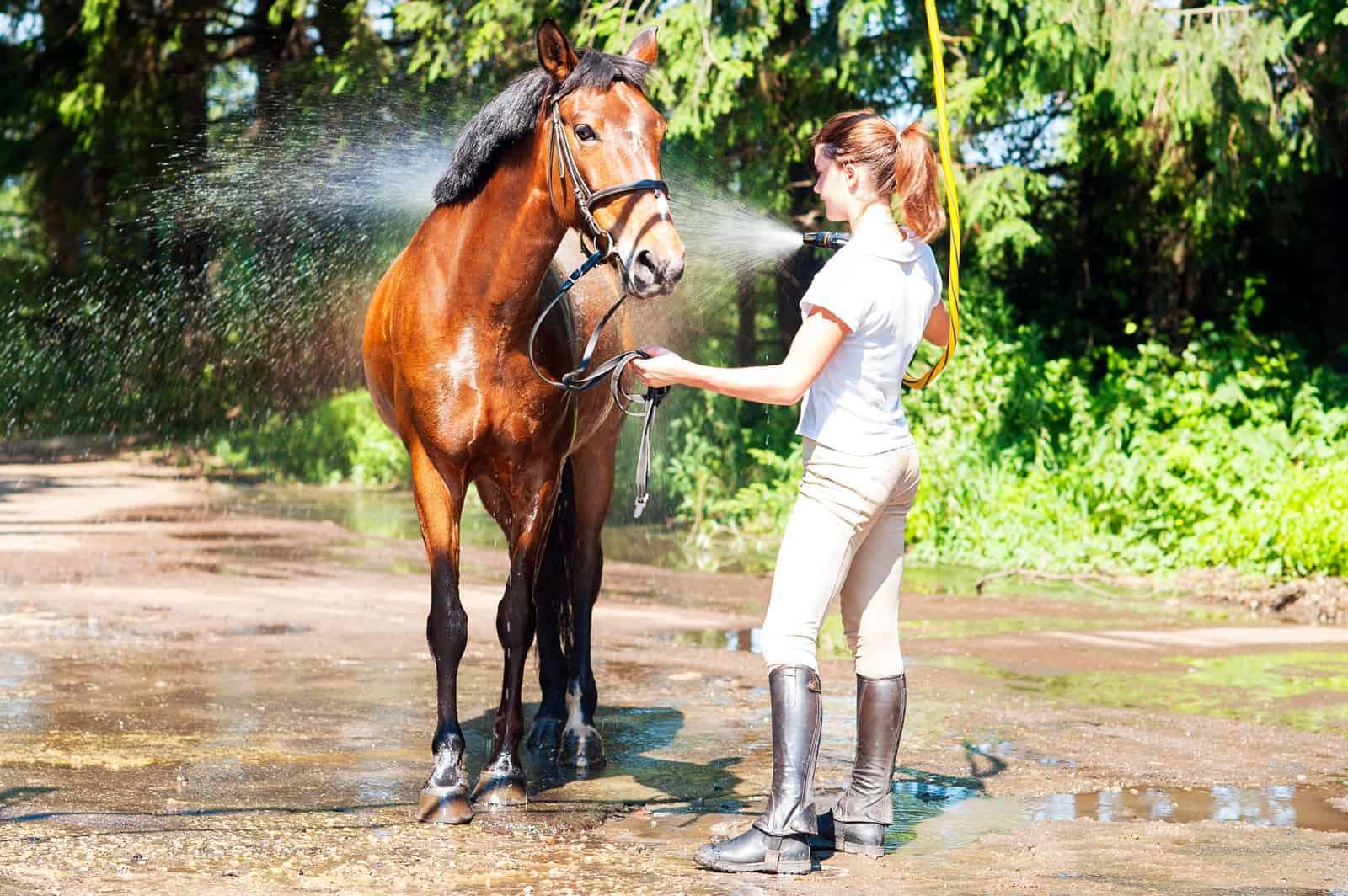10 Hot Weather Horse Care Tips

Summer is a great time to ride, but summer heat can be dangerous for horses, resulting in dehydration, lethargy, and general malaise. Severe heat stress can even cause diarrhea and colic.
In a release issued June 17, Janet Johnston, DVM, Dipl. ACVIM, ACVS, an emergency critical care veterinarian at University of Pennsylvania School of Veterinary Medicine’s New Bolton Center, offers the following tips to help keep your horse healthy and cool as we approach the first day of summer:
1. Choose cooler turnout times. If your horse has a stall, but is turned out for part of the day, provide turnout during the cooler hours. Overnight is ideal, but if that’s not possible, have the horse go outside as early as possible during the day. Remember, the summer heat can also take a toll on the quality of your pasture. You might need to provide additional feed as the grass becomes sparse to maintain proper body condition and energy.
2. Provide shade. If your horse lives outdoors or if he must be outside during the day, provide relief from the sun. A run-in shed is best. Trees are a source of shade, but as the sun moves, so will the shade; ensure that, regardless of the time of day, the trees are offering shade.
3. Move the air. Fans are a great way to help keep the air moving in the barn, but use them wisely. Always ensure that your horse can’t get a hold of cords and plugs.
4. Mist your horse. If you are fortunate enough to have a misting system for your horse, use it. As moisture is absorbed from your horse’s skin, it will take away some of the heat. Frequent mistings are far more effective than a single dousing with a hose.
5. Provide fresh, cool water and an electrolyte source. Make sure your horse has plenty of fresh, cool water. A bucket hanging on a pasture fence will get warm and the water will no longer be appealing. Left long enough, the water will also become stagnant and unhealthy. If you are providing clean, cool water and your horse doesn’t seem to be drinking, then encourage it by providing a salt block, or even by misting hay with salt water. If your horse is sweating a great deal, water laced with electrolytes can help keep its body in balance. Whenever you offer electrolytes, however, be sure to offer a second source of fresh water, as well. Not all horses will drink electrolyte-laced water, so providing a source of water without them will ensure your horse keeps drinking. Also, too many electrolytes can be harmful.
6. Slow down the work. Don’t think that because your horse has been working intensely at 1:00 p.m. every day that it can take the heat when the temperature tops 90°F. If you have to work your horse in the heat, lighten the work or spread it out over a couple of short sessions. This is especially important when the humidity is high, contributing to the poor quality of the air your horse is breathing. Cool your horse down slowly, and offer frequent sips of cool water. Take the tack off as soon as you’re done and sponge the horse off again with cool water.
7. Stick to a schedule. Within the parameters of keeping him cool, try to stay as close as possible to his normal schedule. Too much change at one time can be an invitation for colic.

8. Avoid sunburn. Horses, especially white horses, can suffer from sunburn. Even those with white socks and blazes, pink noses, or hairless patches from scarring can be susceptible. Using a fly scrim can help. In addition, applying sunblock to small, particularly vulnerable areas can be effective. Staying out of the sun’s harmful rays will, of course, be best. (Also be aware: If a horse has excessive sunburn it could indicate a rare, underlying liver disease.)
9. Clip horses with longer hair coats. Clipping is important, especially for those with pituitary pars intermedia dysfunction (PPID, or Cushing’s disease). While some coat can provide protection from the sun and insulation, a long, thick coat tends to hold heat and makes it difficult for the horse to cool down. Be careful not to clip the hair too close, however, as it provides some protection from damaging rays.
10. Know your horse and signs of heat stroke. Heat stroke can happen anytime your horse is exposed to excessive heat that his body cannot handle. Heatstroke can happen if exercising in hot conditions, but be aware that it can also happen if standing in a hot stall or trailer.
You should know your horse’s normal temperature, heart, and respiratory rates. To find the heart rate of a horse, simply find a pulse and count the beats for 15 seconds, then multiply that number by four, which will give the beats per minute. Count the breaths per minute in a similar way.
Signs of heat stroke can include:
- An elevated heart rate that does not return to normal in a reasonable period of time;
- Excessive sweating or lack of sweating;
- Temperature that persists above 103°F;
- Depression and/or lethargy; and
- Signs of dehydration: dry mucous membranes, poor capillary refill, and poor skin turgor.
If you are concerned that your horse is suffering from heat stroke, call your veterinarian immediately and get your horse into a cooler environment.
Written by:
University of Pennsylvania School of Veterinary Medicine's New Bolton Center
Related Articles
Stay on top of the most recent Horse Health news with











